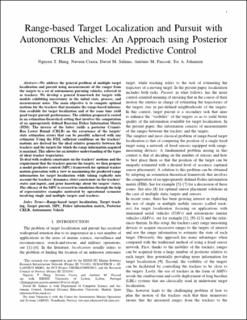| dc.contributor.author | Hung, Nguyen T | |
| dc.contributor.author | Crasta, Naveena | |
| dc.contributor.author | Salinas, D M | |
| dc.contributor.author | Pascoal, António M. | |
| dc.contributor.author | Johansen, Tor Arne | |
| dc.date.accessioned | 2021-02-09T13:42:27Z | |
| dc.date.available | 2021-02-09T13:42:27Z | |
| dc.date.created | 2020-12-21T11:52:57Z | |
| dc.date.issued | 2020 | |
| dc.identifier.issn | 0921-8890 | |
| dc.identifier.uri | https://hdl.handle.net/11250/2726937 | |
| dc.description.abstract | We address the general problem of multiple target localization and pursuit using measurements of the ranges from the targets to a set of autonomous pursuing vehicles, referred to as trackers. We develop a general framework for targets with models exhibiting uncertainty in the initial state, process, and measurement noise. The main objective is to compute optimal motions for the trackers that maximize the range-based information available for target localization and at the same time yield good target pursuit performance. The solution proposed is rooted in an estimation-theoretical setting that involves the computation of an appropriately defined Bayesian Fisher Information Matrix (FIM). The inverse of the latter yields a posterior Cramér–Rao Lower Bound (CRLB) on the covariance of the targets’ state estimation errors that can be possibly achieved with any estimator. Using the FIM, sufficient conditions on the trackers’ motions are derived for the ideal relative geometry between the trackers and the targets for which the range information acquired is maximal. This allows for an intuitive understanding of the types of ideal tracker trajectories. To deal with realistic constraints on the trackers’ motions and the requirement that the trackers pursue the targets, we then propose a model predictive control (MPC) framework for optimal tracker motion generation with a view to maximizing the predicted range information for target localization while taking explicitly into account the trackers’ dynamics, strict constraints on the trackers’ states and inputs, and prior knowledge about the targets’ states. The efficacy of the MPC is assessed in simulation through the help of representative examples motivated by operational scenarios involving single and multiple targets and trackers. | en_US |
| dc.language.iso | eng | en_US |
| dc.publisher | Elsevier | en_US |
| dc.rights | Attribution-NonCommercial-NoDerivatives 4.0 Internasjonal | * |
| dc.rights.uri | http://creativecommons.org/licenses/by-nc-nd/4.0/deed.no | * |
| dc.title | Range-based Target Localization and Pursuit with Autonomous Vehicles: An Approach using Posterior CRLB and Model Predictive Control | en_US |
| dc.type | Peer reviewed | en_US |
| dc.type | Journal article | en_US |
| dc.description.version | acceptedVersion | en_US |
| dc.source.volume | 132 | en_US |
| dc.source.journal | Robotics and Autonomous Systems | en_US |
| dc.identifier.doi | 10.1016/j.robot.2020.103608 | |
| dc.identifier.cristin | 1862281 | |
| dc.relation.project | Norges forskningsråd: 223254 | en_US |
| dc.description.localcode | "© 2020. This is the authors’ accepted and refereed manuscript to the article. Locked until 28.7.2022 due to copyright restrictions. This manuscript version is made available under the CC-BY-NC-ND 4.0 license http://creativecommons.org/licenses/by-nc-nd/4.0/ " | en_US |
| cristin.ispublished | true | |
| cristin.fulltext | postprint | |
| cristin.qualitycode | 1 | |

